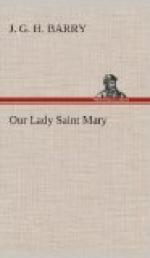Another fact that tells in the same direction is the absence of any physical relics of our Lady. At a time when great stress was laid upon relics, and there was little scruple in inventing them, if the authentic ones were not forthcoming, there were no relics produced which were alleged to be the physical relics of S. Mary. Why was this? Surely, unless there were some inhibiting circumstances, relics, real or forged, would have been produced. The only probable explanation is that the inhibiting circumstance was the established belief in the assumption. If the assumption were a fact, there would be no physical relics; if it were an established belief, there would be no fraud possible. Add to this that various relics of our Lady were alleged to exist; but they were not relics of her body.
Again: by the seventh century the celebration of the feast of the assumption had spread throughout the whole church. This universal establishment of the feast implies a preceding history of considerable length, going well back into the past. The feast was kept in many places, and under a variety of names which seem to imply, not mere copying, but independent development. It is alleged, to be sure, that the names by which the feast was called do not imply belief in the assumption. The feast is called “the Sleeping,” “the Repose,” “the Passage” of the Virgin, as well as by the Western title, the assumption. But a study of the liturgies and of the sermons preached in honour of the feast will convince any one that the underlying tradition was that of our Lady’s assumption.
These quite separate and yet converging lines of evidence seem to me to show convincingly what was the wide-spread belief of the early Christian community as to the destiny of Blessed Mary. They imply a tradition going well back into the past, so far back, that in view of the theological expression of the mind of the Church they may well be regarded as apostolic. Our personal belief in the assumption will still rest primarily upon its theological expression in the mind of the Church, but having attained certainty as to the doctrine, which is of course at the same time certainty as to the fact, we shall have no difficulty in finding in the above sketched lines of historical development the evidence of the primitive character of the belief.
It may not be amiss to give a few characteristic quotations as indicating the mind of the Church in this matter.
S. Modestus, patriarch of Jerusalem (d. 614), preaching on the Falling Asleep of the Mother of God, said:—
“The Lord of heaven and earth has to-day consecrated the human tabernacle in which He Himself, according to the flesh, was received, that it may enjoy with Him forever the gift of incorruptibility. O blessed sleep of the glorious, ever-virgin Mother of God, who has not known the corruption of the grave; for Christ, our all-powerful Saviour, has kept intact that flesh which gave Him His flesh.... Hail, most holy Mother of God: Jesus has willed to have you in His Kingdom with your body clothed in incorruptibility.... The most glorious Mother of Christ our Lord and Saviour, Who gave life and immortality, is raised by her Son, and forever possesses incorruptibility with Him Who called her from the tomb.”




